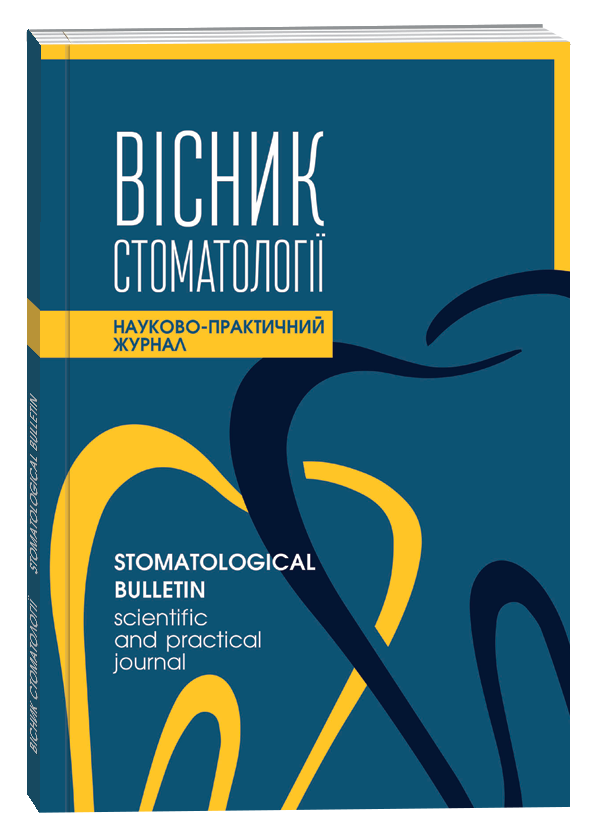EVALUATION OF ANTHROPOMETRIC AND CEPHALOGRAPHIC PARAMETERS IN PATIENTS WITH DISTAL BITE WITH NORMAL AND IMPAIRED EXTERNAL RESPIRATORY FUNCTION
DOI:
https://doi.org/10.35220/2078-8916-2022-45-3.14Keywords:
distal bite, impaired external respiratory function, TRG, anthropometric studies.Abstract
Introduction. Distal bite is one of the most common problems in orthodontic practice and is accompanied by certain morphological, functional and aesthetic changes: a violation of the dynamic balance of the muscles of the perioral region and tongue, in which a number of functions of the child suffer: there are violations of the function of external respiration, speech, chewing and swallowing functions. Purpose of the work. Study of the features of anthropometric and telerentgenographic parameters in patients aged 7-13 years with complex forms of distal occlusion with normal and impaired external respiratory function. Research methods. We examined 231 children aged 7 to 13 years with distal bite, in the period of variable bite, at the peak of growth (CS3 and CS4 – puberty stages). The peak of puberty was determined by hand-wrist X-ray analysis, CVM (cervical vertebra maturation) method, and chronological age. Cephalometric analysis with determination of anatomical landmarks, lines and parameters for assessing the base of the skull, jaw position, hyoid bone, soft palate, cervical vertebra, pharynx (nasopharynx, oropharynx and laryngopharynx). Anthropometric measurements of the width of the dental Arch By Method A. Pont, the length of The Frontal segment of the dental arch – according to the G method.Korkhaus. Research results. According to the results of the study, all anthropometric and TRH indicators were significantly worse in patients with impaired external respiratory function, especially in patients in Class II of the English subclass, which leads to a deterioration in the course of the disease and predicting the effectiveness of its treatment. Conclusions. In order to determine the effectiveness of orthodontic treatment of distal bite, it is necessary to conduct an anthropometric and cephalometric study before and after the treatment in order to determine its effectiveness.
References
Дорошенко О.М., Лихота К.М., Дорошенко М.В., Бiда О.В. Дослiдження функцiонального стану жувальних м'язiв у пацiєнтiв рiзних вiкових груп iз сагiтальними аномалiями прикусу. Збiрник наукових праць спiвробiтникiв НМАПО iменi П Л. Шупика. 2015. Вип. 24 (2). С. 58-64.
Смаглюк Л.В., Дмитренко М.І. Дистальна оклюзія і скупченість зубів: стратегія лікування. Український стоматологічний альманах. 2020. № 2. С. 103-108.
Фур М. Б. Характер зубощелепних аномалій у дітей з соматичною патологією, які перебувають в інтернатних закладах. Вісник стоматології. 2018. № 2. С. 35-41.
Глазунов О.А., Рабовил М.І., Дрок В.О. Порівняльна характеристика зовнішнього дихання у дітей 6-8 років з дистальним прикусом. Вісник стоматології. 2016. № 4. С. 42-45.
Tsai H.H., Yin Ho C., Lee L.P. Cephalometric analysis of non-obese snorers either with or without obstructive sleep apnea syndrome. Angle Orthod. 2007. № 77(6). Р. 1054-61.
Bibby RE, Preston CB. The hyoid triangle. Am J Orthod. 1981. № 80. Р. 92-97.
Kumar K.J. A study of hyoid bone position and its relation to the oral and pharyngeal spaces in normal and malocclusion subjects. Master’s Thesis. University of Kerala; 1983.
Tweed C.H. The Frankfort-Mandibular Incisor Angle (FMIA) In Orthodontic Diagnosis, Treatment Planning and Prognosis. The Angle Orthodontist. 1954. № 24(3). Р. 121-69.
Freitas M.R., Alcazar N.M.P.V., Janson G., Freitas K.M.S., Henriquesas J.F.C. Upper and lower pharyngeal airways in subjects with Class I and Class II malocclusions and different growth patterns. Am J Orthod Dentofacial Orthop. 2006. №.130. Р. 742-745.
Tepedino M., Illuzzi G., Laurenziello M., Perillo L., Taurino A.M., Cassano M., et al. Craniofacial morphology in patients with obstructive sleep apnea: cephalometric evaluation. Braz J Otorhinolaryngol. 2020.
Lakshmi K.B., Yelchuru S.H., Chandrika V., Lakshmikar O.G., Sagar V.L., Reddy G.V. Comparison between growth patterns and pharyngeal widths in different skeletal malocclusions in South Indian Population. J Int Soc Prevent Communit Dent. 2018. № 8. Р. 224-8. 12. Dalmau E., Zamora N., Tarazona B., Gandia J.L., Paredes V., A. Comparative Study of the Pharyngeal Airway Space, Measured with Cone Beam Computed Tomography, Between Patients with Different Craniofacial Morphologies, Journal of Cranio-Maxillofacial Surgery. 2015. № 438. Р. 1438-46 DOI: 10.1016/j.jcms.2015.06.016
Nadja e Silva N., Lacerda R.H.W., Silva A.W.C., Ramos T.B. Assessment of upper airways measurements in patients with mandibular skeletal Class II malocclusion. Dental Press J Orthod. 2015. № 20(5). Р. 86-93.
Qingzhu Wang, Peizeng Jia, Nina K. Anderson, Lin Wang, Jiuxiang Lin. Changes of pharyngeal airway size and hyoid bone position following orthodontic treatment of Class I bimaxillary protrusion. Angle Orthodontist. 2012 Vol 82. № 1. Р. 115-21. doi: 10.2319/011011-13.1. Epub 2011 Jul 27.
Arnim Godt, Bernd Koos, Hanno Hagen, Gernot Goz. Changes in upper airway width associated with Class II treatments (headgear vs activator) and different growth patterns. Angle Orthodontist. 2011. Vol 81, № 3. Р. 440-6. doi: 10.2319/090710-525.1
Castro AMA, Vasconcelos MHF. Avaliação da influência do tipo facial nos tamanhos dos espaços aéreos nasofaríngeo e bucofaríngeo. Rev Dental Press Ortod Ortop Facial. 2008. № 13(6). Р. 43-50. doi.org/10.1590/ S1415-54192008000600006









